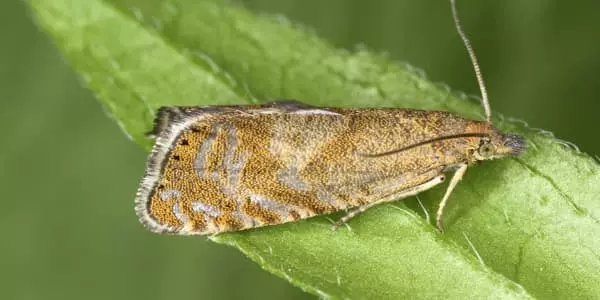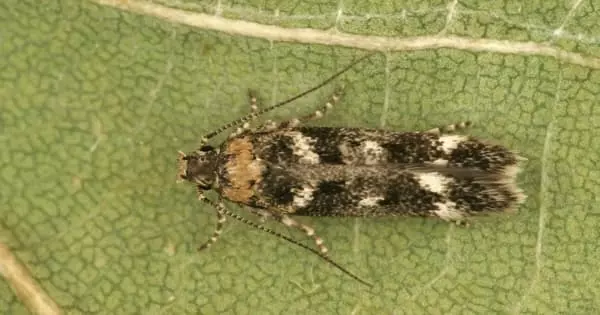The Alpine rose leaf-miner moth, a previously unknown glacial relic in the Alps, was discovered by a research team. It is the first known species with caterpillars that feed on the rust-red alpine rose, a highly poisonous, widely distributed plant that most animals, including moths and butterflies, avoid.
The Alpine rose leaf-miner moth, a previously unknown glacial relic in the Alps, was discovered by an Austrian-Swiss research team. It is the first known species with caterpillars that feed on the rust-red alpine rose, a highly poisonous, widely distributed plant that most animals, including moths and butterflies, avoid. The incredible achievement was recently published in the peer-reviewed scientific journal Alpine Entomology.
Poisonous host plant
Because of its flowering splendor, the rust-red alpine rose (Rhododendron ferrugineum) is one of the best-known and most attractive plants – at least to humans. It is, in fact, a highly poisonous plant that grazing animals must avoid at all costs. The alpine rose is most appealing to insects as a nectar plant; insect larvae, on the other hand, develop on it only in exceptional circumstances. This also applies to Alpine butterflies and moths, which, despite their widespread distribution, leave Alpine roses largely untouched. As a result, the discovery of a highly specialized species in the Alps was completely unexpected.
The accidental discovery of the first caterpillar in an alpine rose leaf was an absolute adrenaline rush; it was immediately clear that this had to be an extraordinary species. The extensive search yielded evidence of a stable population of a species that was previously unknown.
Peter Huemer
Chance find
Because alpine roses are unappealing to caterpillars and no insect in the Alpine region had previously been known to specialize on them, butterfly and moth experts dismissed them as uninteresting and ignored them in their research. The discovery of the alpine rose leaf-miner was not the result of a deliberate search: it was purely coincidental.
During a cloudy spell in July this year, researchers surveying butterflies in Ardez, Switzerland’s Engadine valley, happened to take a break right next to an infested alpine rose bush.
“The accidental discovery of the first caterpillar in an alpine rose leaf was an absolute adrenaline rush; it was immediately clear that this had to be an extraordinary species,” says Peter Huemer, researcher and head of the natural sciences department at the Tyrolean State Museums. He returned in late July and early August with Swiss butterfly and moth expert Jürg Schmid to look for caterpillars and pupae and learn more about this strange insect. The extensive search yielded evidence of a stable population of a species that was previously unknown.

Life in the leaf
After the caterpillar hatches, the alpine rose leaf-miner moth drills through the upper leaf skin and into the leaf interior. The caterpillar then spends the rest of its life, until pupation, between the intact leaf skins, eating the leaf from the inside. Because of this behavior, the caterpillar is equally protected from bad weather as it is from many predators such as birds, spiders, and carnivorous insects. The feeding trail, known as a leaf mine, starts with a long corridor and ends in a large square-shaped mine section. The feces have been deposited within this mine. When the caterpillar is ready to pupate, it leaves the infested leaf and spins a typical web on the underside of a nearby leaf.
It creates an elaborate “hammock” with the help of several fine silk threads, in which the pupation finally occurs. After about 10 days, successful breeding to a moth was achieved in the laboratory, with a stunning result.
Mysterious glacial relic
Huemer and Schmid were surprised to learn that the moths belonged to a species found throughout northern Europe, Asia, and North America: the swamp porst leaf-miner butterfly Lyonetia ledi. They were able to confirm its identity by examining its morphological features, such as wing color and pattern, and comparing its DNA barcodes to those of northern European specimens.
The Engadine population, on the other hand, is located more than 400 kilometers away from the nearest other known populations, which are located on the border of Austria and the Czech Republic. Furthermore, the species only survive in Northern Europe on swamp porst and Gagel bush, two shrubs found in raised bogs but not in the Alps. However, the researchers believe that the swamp porst and the alpine rose shared habitat in perialpine lowland habitats north of the Alps during earlier cold phases (22,000 years ago). It is very likely that following the last cold period and glacier melt, some populations of the species shifted their host preference from swamp porst to alpine rose. The separation of the two plants’ distribution areas caused by subsequent warm phases inevitably resulted in the separation of the moth populations.
Extinction risk
So far, the Alpine Rose Leaf-miner Moth has only been found in the Lower Engadine. It lives on a steep, north-facing slope in a spruce-larch-pine forest about 1,800 meters above sea level. Because of the heavy snow cover in winter and the mostly shady conditions in summer, alpine roses do not bloom there. The scientists believe that the moth species can still be found in areas of the northern Alps with similar conditions, such as neighboring Tyrol and Vorarlberg. The search for caterpillars and pupae is more promising because the moth is likely nocturnal and flies late in the year, likely hibernating in the adult stage. However, the unique microclimate of the Swiss location suggests that this species, which has gone unnoticed despite 250 years of research, is not widespread. On the contrary, there are legitimate concerns that it could be one of the first victims of climate change.
















